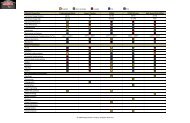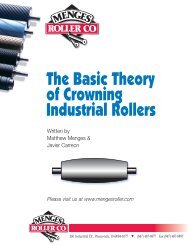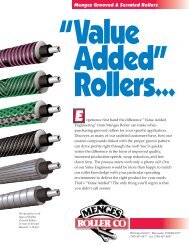Carbon Fiber Rollers - Menges Roller Company, Inc.
Carbon Fiber Rollers - Menges Roller Company, Inc.
Carbon Fiber Rollers - Menges Roller Company, Inc.
You also want an ePaper? Increase the reach of your titles
YUMPU automatically turns print PDFs into web optimized ePapers that Google loves.
Physical Advantages of <strong>Carbon</strong> <strong>Fiber</strong> <strong><strong>Roller</strong>s</strong><br />
<strong>Carbon</strong> <strong>Fiber</strong> materials, developed for aerospace applications, are gaining increased acceptance in<br />
industrial roller applications because of their reduced weight and inertia, and high relative stiffness.<br />
Looking at the chart below you can see that for a 3.5 inch diameter roller with a 74 inch face length,<br />
quarter inch wall, that the carbon fiber roll weighs about 20% of what a comparably dimensioned steel<br />
roll would weigh, and 58% of what an aluminum roll weighs. This reduced mass results in reduce<br />
bearing loads, which increases bearing life and therefore reduces maintenance costs. In addition, ease of<br />
maintenance is increased as large rolls can be handled by a single man without crane support.<br />
<strong>Carbon</strong> fibers are manufactured of two types of material: PAN (polyacrylonitrate) fibers and pitchbased<br />
fibers. Each type has its own advantages. The PAN carbon fiber has about 50% higher ultimate<br />
strength than the pitch-based fiber roll, but the pitch-based fiber roll has a Modulus of Elasticity<br />
approaching that of steel, resulting in less roll deflection. The carbon fiber roll can have as little as 35% of<br />
the deflection of an aluminum roll.<br />
The reduced weight also results in higher resonant frequencies. By the chart below, the pitch-based<br />
carbon fiber roll has a resonant frequency twice as high as a steel roll, resulting in the potential of twice<br />
the processing line speed. The reduced weight also results in a reduced mass moment of inertia. By the<br />
chart below the carbon fiber roll has about a fifth of the mass inertia of a steel roll. This means it will take<br />
one fifth of the torque to accelerate the roll to line speed and one fifth the energy, resulting in reduced<br />
operating costs.<br />
EXAMPLE: IDLER ROLL - 3.5”diameter - .25” wall - 74” face length - internal bearings<br />
web width 74” - wrap angle 180º - web tension 1 PLI<br />
Material<br />
Steel<br />
Aluminum<br />
PAN<br />
<strong>Carbon</strong> <strong>Fiber</strong><br />
Pitch<br />
<strong>Carbon</strong> <strong>Fiber</strong><br />
Modulus of<br />
Elasticity<br />
lbs/in^2<br />
30,000,000<br />
10,000,000<br />
16,000,000<br />
28,000,000<br />
Density<br />
lbs/in^3<br />
0.283<br />
0.098<br />
0.057<br />
0.063<br />
Area Moment<br />
of Inertia<br />
in^4<br />
3.3901<br />
3.3901<br />
3.3901<br />
3.3901<br />
Weight<br />
lbs<br />
53.46<br />
18.51<br />
10.77<br />
11.9<br />
Mass Moment<br />
of Inertia<br />
lbs x in^2<br />
142.0389<br />
49.1866<br />
28.6085<br />
31.62<br />
Natural<br />
Frequency<br />
Hz<br />
66.9<br />
65.6<br />
108.9<br />
137<br />
Critical<br />
Speed<br />
ft/min<br />
3678<br />
3607<br />
5988<br />
7533<br />
Deflection<br />
in<br />
0.0038<br />
0.0115<br />
0.0072<br />
0.0041





